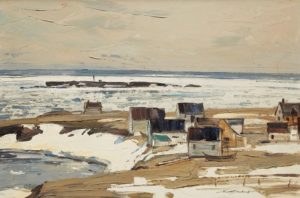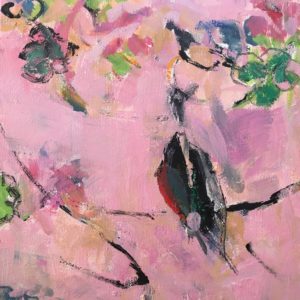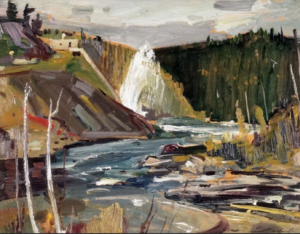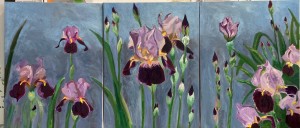Dear Artist,
An excellent Quebec painter, Lorne Bouchard, once gave me some advice. He told me that a painter needs to work from three sources — from self-generated photo reference, from life, and from the imagination. “All painters,” he said, “favour one or the other, but all three are needed to gain maximum feeling — and this goes even for abstractionists and those others who glean their motifs from their minds.”

Spring, Point St. Peters, Gaspé Coast, 1961
Oil on board
16 x 24 inches
by Lorne Bouchard, RCA (1913 – 1978)
This advice came at a time when I was chronically “P.D.” (Photo Dependent). It took me another decade to realize the value of Lorne’s advice. I’d always thought that photos, used properly, had the coded information needed to make patterns and design decisions. Furthermore, photos side-stepped what I saw as the rigmarole of live observation. This all came at a time when I was struggling with perceived limitations of my pictorial imagination.
Then I saw the light. Flirting with plein air, I was returning from outdoor sorties and encountering photo-based as well as imaginary work in my studio. I saw barrenness and lack of elan. I realized that works conceived theoretically and outside the real world were somehow lacking in the truth I was after.

Spring Pond, Country of Two Mountains, Prov. of Quebec, 1966
Oil on board
12 x 16 inches
by Lorne Bouchard
The outdoor connection has something to do with walking on the loose flints themselves, the feelings of change, atmosphere, and the effects of timing. Last week in the Queen Charlotte Islands, left alone to my own devices on a remote beach, I was set upon by some fancy weather. After a blast of rain had me under an umbrella, I moved into the nearby forest for shelter. I was soon overtaken by a pervasive “Scotch mist” that turned out to be a remarkable moisturizer of the acrylic palette and canvas. “An inconvenience is an unrecognized opportunity,” I remembered from Confucius. The paint on the canvas moved around on its own. The effects were like nothing I’d done before. Point is, I’d never have figured this out from a photograph or from the wiles of imagination.
Looking and seeing on location, or working from life, adds a living presence to work. Gathering becomes an event. Life reboots visual memory. If you add life to self-generated reference and the muscle of imagination, better work is more likely to appear.
Best regards,
Robert
PS: “You can be bashed around in the bush. If your hands freeze, your face burns, or the mozzies suck your blood, so much the better.” (Lorne Bouchard, 1913-1978)
Esoterica: Without the third muscle of imagination, whether as pure play or an adjunct to reality, art is bound to fall flat. Asking the question “What could be?” at every stage of your process is the magic moxie that makes art. Imagination is the mother of style. Artists, particularly younger ones, often find the three approaches generate three different styles. This tendency becomes less apparent as an artist matures. The later work of Lorne Bouchard, for example, was consistently loose, casual and cursory. Looking at individual paintings it’s difficult to say from which of the big three his inspiration came.
This letter was originally published as “The big three” on July 17, 2007.
“No design is possible until the materials with which you design are completely understood.” (Ludwig Mies van der Rohe)
Featured Workshop
 Permission to Paint Expressively Series Session 2
Permission to Paint Expressively Series Session 2
August 22-25, 2022
Join Ellie Harold for “Expressive Painting: Making Your Marks.” With a focus on intuitive mark-making, this workshop is designed to facilitate a fuller expression of your deepest and most essential artist Self. Content, process and lightly structured exercises give you permission to create the art that wants to be made by you in the safe space of Ellie’s studio and the fresh air and cool light of northern Michigan near Sleeping Bear Dunes. You’ll return home with a specific art “care plan” to assure support for “Making Your Marks” in the world. Details and registration at www.EllieHarold.com.
Featured Artist
All of my paintings are an exploration – either representational of people and nature or non-representational work that explores bits of poetry and always, nature.
I work in acrylic for non-representational work and oil for the representational paintings.
I find that the more connected I am to the content, the more successful the painting seems to be. Content comes from family, from my love of nature from travel and reading.






102 Comments
Wow! the limited old master’s palette is beautiful in these pieces. As a person who loves lots of color in my work, I find the old master’s palette very restful and peaceful and occasionally force myself to work in it. It is a good lesson to practice and the results are usually wonderful.—Burnt Sienna, Yellow Ocher, and Ultramarine Blue.
Absolutely. What a terrific P.O.V. And reminder. I would amend the list, and add “copy.” Copying the masters along with working from life and inventing seems to cover all bases. Love Robert’s views…always….
I needed to share with you all how important this newsletter has been in educating me as an artist, and giving me emotional support when I begin to doubt. It is an invaluable resource and I appreciate it greatly. Thank you. For your generosity is sharing your and Roberts wisdom so freely. Lilly Killbear artist.
Now I remember this letter from those years ago when I began reading Robert Genn’s letters! I had now forgotten its importance but it all comes back again now , thanks for ”this reminder Sarah It caught me at a time when I was unsure of whether I should perhaps take a break from painting . With this reminder I will
get back to my easil and palate with new energy . Thanks for your help
I believe with all my heart that Robert is right in what he says about the benefits of painting on location. I admire his tenacity as much as I admire his paintings, incredible. But, for those of us who can’t up-and-go to capture the true essence of nature in the field, using the photos we gather as stepping stones into the joy of making a painting has to be good enough. I tried to go on location in the past. I learned quickly doing this on a now and then schedule was not enough. To be a good plein air painter you have to go regularly in order to adapt to so many things. I became frustrated at the loss of time I could have used in the studio coming up with a decent painting only to have to scrape off mud. Accepting our own way of being an artist is okay. Maybe the day will come when I can take off and paint plein air because I have all the time in the world just for that, maybe. For now I’m okay with just the two of the three steps required. I have a good imagination, I can return to the place in the physical while I paint where I took the photo. :)
I am one of those who also have a difficult time with plein aire. Bugs, wind and mud. Not that I haven’t tried, and once in a while with a half decent result. Sometimes I have captured the colours more realistically. But, for the most part, my basement storage racks are full of my plein aire failures. so I have to say I am happy being a studio painter. There is one thing I must add though so you won’t think I am dismissing the effort all together. A photo takes only a moment of time to compose and snap. A graphite sketch, field painting or study takes long enough that one must be immersed in the scene for enough time to commit it to memory and learn something of its essence. This, I think, is the true value of field painting. To stay in the presence of the subject long enough to get past the superficials. If one comes away with a workable image, well that’s even better.
An excellent point, Michael, eloquently stated! Thanks for that insight, and best regards!
This comment is mostly for Sara…a gigantic thank you for republishing this superb piece written by your dear father. I did not know your father when this was first published. Prior to today’s posting, I had never previously seen any artist’s work that reminded me of your Robert’s. His style was so amazingly unique. Now after seeing the work of Bouchard, I am guessing that he greatly influenced your dad as a young artist, and rightfully so. What a joy to gain both the wisdom in today’s painter’s key and to view a man who perhaps influenced your accomplished father in his own art career. Thank you once again.
Oops. I see I forgot to delete the “your” in the third sentence. Sorry about making my post confusing!
Another pitfall of working from photos is that they are not as “correct” as people think, particularly for those taking photos with their phones. The lens distorts shapes and distances, enhances certain pre-chosen colors, dials up contrast, is often sharper than what the eye sees, etc. Working from life reminds you of that. Adding in a dollop of imagination … helps you improve on both life and photos. Put your own spin on it.
I just came home with two less than perfect paintings from an en plein air outing. I’ll look at them tomorrow and decide if I will just gesso and try again another day. Practice should improve things.
Trailmakers Free Download is a natural developer computer game. It is the most famous computer game among all the genius gamers and beginners. visit this link for more information.
ekc9bt
dhneh5
pwqqz5
sxdqkx
8nrxbh
h7o1tm
vwi9vv
Thank you for sharing this enlightening perspective on the creative process. It’s a testament to the enduring relevance of Bouchard’s advice and the ongoing Tunnel Rush exploration of artistic expression.
th71ek
hrlyj3
owomda
Thanks This comment is mostly for Sara…a gigantic thank you for republishing this superb piece written by your dear father.
5wdrif
I am appreciative of your crucial contribution to my professional advancement and for providing me with a hopeful outlook on the future.
vn96vl
p70bx4
b9yocx
bj0pie
c60e2z
eeog0l
hirfu5
mj08l1
v8s8hf
7xlhu6
2glp8r
7haf9m
qi2q3v
In order to become a proficient plein air painter, you must visit frequently and learn to adapt to a variety of situations. Regards from arborist hamilton!
nf8avl
otpkrd
excc7y
gvbggp
fvxult
9jcq0d
szpttb
7fqz22
vw9fya
po9j3w
y4y6oy
0o5zsi
t6f1vp
msavvu
zfadvz
ynm3r1
i49dcy
di9gfi
57wigw
wjd99d
hkoxom
uhwa73
6i5tmm
opie08
0ryhok
8yqqf6
wxdxfg
4qowr8
ro6klh
k6o2nc
5misfg
4ray9p
yn47z8
ctl6pf
weiln9
eokma2
km3kgz
rx76ww
0u9eaz
avqg23
0vwk53
jz0h0e
b556hu
g6fxzj
83tpmp
z0h78x
51bpg6
5n3v6t
I became aware that the truth I was seeking was somehow missing from works that were conceptualized conceptually and outside of reality. In this case, you can consider hvacbronxny.com team.
b8xqra
5l4hom
871fbd
m4yqs6
dhxb3r
sducxs
iqecym
r4wyjy
disd0t
kbitiu
tqqe55
0b6j51
360a5b